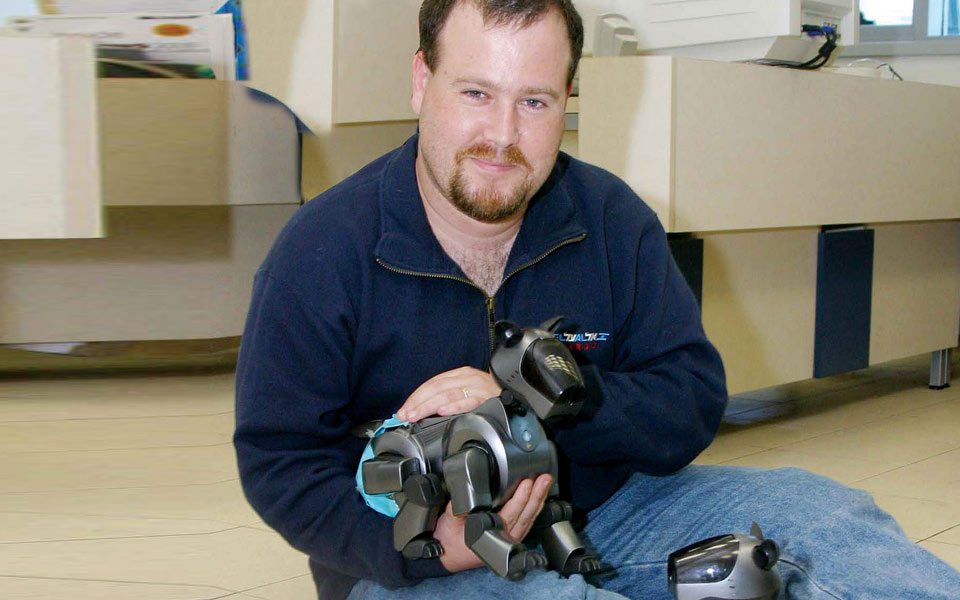ROBOTICS & ENGINEERING
ROBOTICS & ENGINEERING
ROBOTICS & ENGINEERING
BAR-ILAN UNIVERSITY
Moving the Theoretical into the Practical
FROM HOUSEHOLD HELP
TO SEARCH AND RESCUE
Bar-Ilan Robotics Consortium, based in the Computer Science department of the University, is one of the largest computer science research groups in Israel.
The consortium conducts research in robotic technologies relevant to industrial and social tasks. Among its research components are security robotics, multi-robot systems, cognitive modeling and Robocup – soccer-playing robots. Autonomous robot teams are useful in household tasks, search and rescue missions, and security.
BAR-ILAN ROBOTICS
FOR INDUSTRY & GOVERNMENT
Robot team methods were devised for patrolling borders – significantly reducing infiltrators’ ability to breach defenses – and for searching buildings under the supervision of a human operator. Cognitive models of humans, computer programs that can behave like humans and understand human actions and intent, are also being designed.
Bar-Ilan’s Robotics Consortium also works closely with government and industry clients in order to develop and implement cutting-edge robotic technologies. Bar-Ilan’s Robotics Consortium consists of three labs headed individually by Professor Gal Kaminka, Dr. Eli Kolberg and Dr. Noa Agmon.
ENGINEERING:
CONCEPT TO IMPLEMENTATION
The School of Engineering’s student body and faculty is a veritable rainbow of Israel’s diverse population – with native Israelis, students from the United States, former Soviet Union and many other countries.
The School has also attracted and absorbed a number of returning Israeli scientists who have completed fellowships and post docs abroad. They are now active in a wide range of exciting research areas such as Lab-On-Chip, Voice Recognition and Bio-Engineering.
Students of this School play a vital role in this rapidly evolving sector: Computer Engineering Communications, signal processing and Micro-Electronics. Most significantly, the School of Engineering has been educating and training individuals in ways to develop smaller, faster and less costly systems, as well as Electro-Optics that utilizes the natural relationship between electricity and light.
NEXT GENERATION OF
INDUSTRIAL PIONEERS
Interest in graduates of BIU Engineering has been shown by Israel’s defense establishments and many high-tech industry leaders such as Motorola, Intel, RAD, Orckit, ECI and Tadiran, many of whom participate in several of the School’s R&D projects.
The School of Engineering provides: intense practical training for high demand disciplines, as well as a streamlined curriculum focused on practical industrial applications. The School boasts fourteen laboratories dedicated to research and fifteen cutting edge-teaching and project labs.
The School of Engineering’s complex consists of four interlinked buildings, each a home to a sub-discipline: The Mina and Everard Goodman Computer Engineering Building, The Mordecai and Monique Katz Information Technology Building, the Aharon and Rachel Dahan Electronic Technology Building and the Marc Rich Bio-Engineering Building.

Professor Gal Kaminka, a married father of three, is a researcher in robotics at BIU’s Computer Science Department and Gonda Multidisciplinary Brain Research Center. He also heads the university’s MAVERICK group (Multiple Agents, Virtual Environments, Robot Intelligence, Cooperation and Knowledge).
“We’ve achieved incredible successes with AI that impact our lives every day,” explains Kaminka. “In recent years we’ve been working a lot on robot patrols – how a team should behave on patrol, how it should move along a fence in order to identify infiltration, and so on.”
Professor Kaminka and his team have collaborated with a company called Cogniteam, building a software and hardware system to put in small robots used by the army to broadcast video in the field. When several robots work together, they respond to orders but also have the autonomy to choose where to go unless directed otherwise. This way, mapping takes significantly less time and the risk is lessened for soldiers who are waiting outside.


